AMD shipped its original Radeon HD 7970
in December 2011, and for a brief period, this 4.3-billion-transistor
monster held the graphics performance crown. Several months later,
Nvidia launched the GTX 680, a power-efficient graphics card that retook the slot as the best single GPU card for gaming.
In some ways, though, the GTX 680 is an odd beast. Nvidia has been
reluctant to supply what's called GPU compute performance, and it’s
been suggested that Nvidia deemphasized the compute performance in
search of gaming performance glory. The latest GTX 680 drivers don’t
support OpenCL 1.2 (more on that later), though you can still run
Nvidia’s own CUDA framework for GPU compute.
That’s proved a good product strategy, but now we’re starting to
see a new generation of games that integrate GPU compute features into
the game, either using DirectCompute or OpenCL. We’ll take a look at a
couple of these games later. For now, let’s run down the key differences
between the original and the new card.
| Feature | Radeon HD 7970 | Radeon 7970 GHz Edition |
| Graphics Cores | 2048 | 2048 |
| Texture Units | 128 | 128 |
| ROPs | 32 | 32 |
| Base Clock Frequency | 925 MHz | 1006 MHz |
| Boost Clock Frequency | NA | 1050 MHz |
| Memory (Frequency) | 3GB GDDR5 (1376 MHz) | 3GB GDDR5 (1500 MHz) |
| Memory Interface | 384-bit | 384-bit |
| Transistor Count | 4.3 billion | 4.3 billion |
| Display Connectors | 1 x Dual Link DVI, 1 x HDMI 1.4a (Fast), 2 x mini-DisplayPort 1.2 | 2 x Dual Link DVI, 1 x HDMI 1.4a (Fast), 2 x mini-DisplayPort 1.2 |
| Power Connectors | 1 x 8-pin, 1 x 6-pin PCIe | 1 x 8-pin, 1 x 6-pin PCIe |
| Thermal Design Power (TDP) | 250W | 250W |
AMD claims the core clock boost from 925MHz to 1GHz is due to better
understanding of the manufacturing process and a few tweaks to that
process. The reference card has a sticker on the back labeled “Rev 02”,
though that probably refers to the card as a whole. Since a number of
AMD partners already ship cards running in excess of 1GHz, officially
supporting that clock speed isn’t a surprise.
AMD is also building the new version with faster memory—the same
6GHz effective memory that Nvidia uses on the GTX 680. But perhaps most
interesting is the new “boost clock”—something that Nvidia implemented
in the GTX 680. AMD tweaked its PowerTune technology, which manages the
power envelope of the card, to allow for slightly higher core clock
speeds if power demands aren’t too high.

It’s pretty simple: AMD simply added new P-states to PowerTune to allow for higher clock rates for short periods of time, when needed.
The Test System
All our performance and power tests were run on our standard graphics test system:
- Intel Core i7-3960X @ 3.3GHz
- Asus P9X79 deluxe motherboard
- Intel RT2011 sealed liquid CPU cooler
- 16GB Corsair DDR-1600 memory (quad-channel)
- Corsair AX1200 power supply
- 1TB Seagate 7200.12 HDD
- Asus Blu-ray reader / DVD writer
- Corsair Graphite 600T case
The system was not overclocked. A Watts Up Pro USB power meter
collected the system power data. All the game tests are reported at 2560
x 1600 pixel resolution with 4x multisampling antialiasing enabled.
Power Draw
The architecture hasn’t changed, and the AMD reference card looks
nearly identical, right down to the display connectors and fan. However,
PowerTune Boost, the higher core clock speed, and the faster memory
does come at a cost—while idle power is actually a little better than
the original, at 120W (versus 124W for the first Radeon HD 7970), full
load power is a whopping 384W, over 18 percent higher than the 324W
maximum power draw on the original HD 7970. The GTX is more
power-efficient than either card, at 119W idle and 318W under load. Note
that the HD 7970 GHz Edition still uses the same power connectors as
the first 7970—one 8-pin PCIe power connector and one 6-pin connector.
The new AMD progeny is the same 11-inch length as the original; both are
a half-inch longer than the GTX 680.

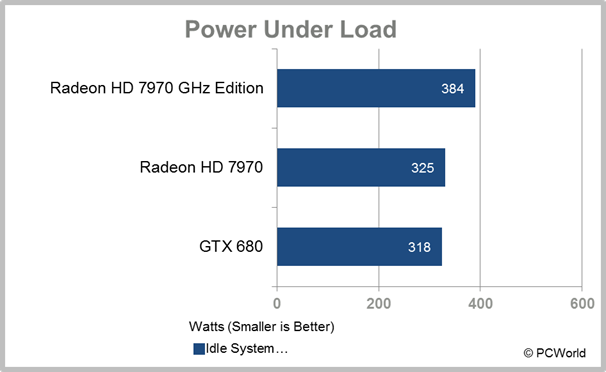
These are power ratings for a system with a 1200W PSU.
What this also means is that the card may be louder, depending on
the cooling system design. Certainly the reference GHz Edition card is
noisier under full load than the original HD 7970.
Given the right case and cooling system, though, noise can be
mitigated somewhat. How does the card peform? We ran through a number of
our standard synthetic and game benchmarks, plus a pair of new game
tests, which make heavier use of GPU compute.
The 3DMarks
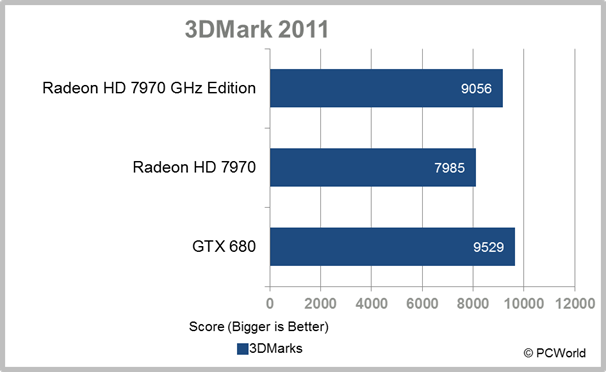

Nvidia’s GTX 680 has an impressive tessellation engine, which is
reflected in the 3DMark 2011 score. That’s the one benchmark that
demonstrated a significant advantage for the GTX 680. The 3DMark Vantage
test uses DirectX 10, so it’s a closer race in that benchmark.
Game Performance
But it is game performance that’s important here, so let’s see how
our suite of games runs on the three GPUs. First, we’ll look at the
older tests, which aren’t as GPU-compute-heavy.
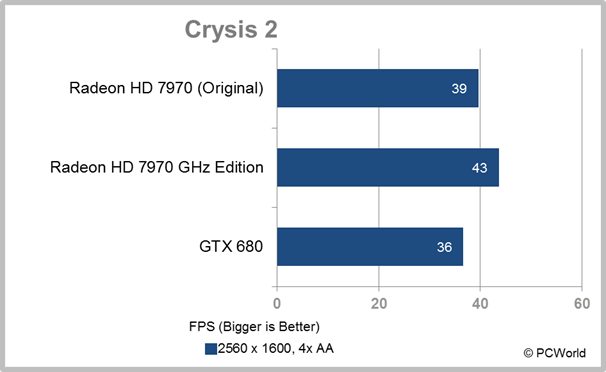
The original 7970 has a slight edge over the GTX 680 in Crysis 2. The GHz Edition Radeon opens up a bigger lead.
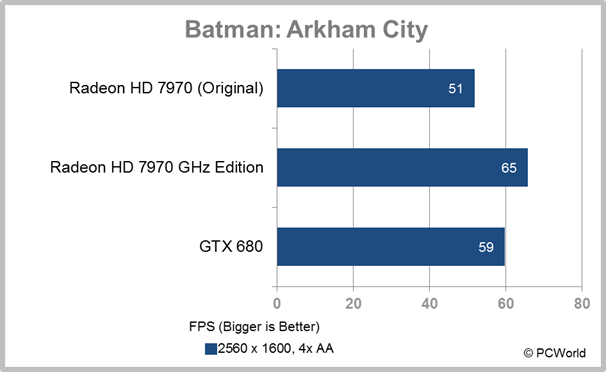
The GTX 680 had a strong lead over the original HD 7970, but the GHz Edition 7970 wins out.
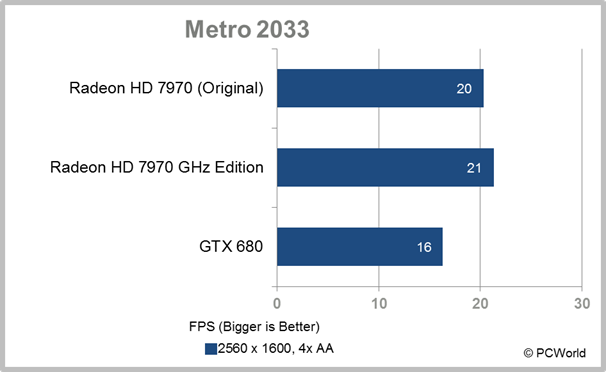
In Metro 2033, the two Radeons have little difference, but the GTX 680 seems to lag in this game test.

The faster memory, wider memory bus, and higher core clocks give the new GHz Edition 7970 a big boost in DiRT 3.
The newer Radeon performs noticeably better than the original, and
outpaces the GTX 680 as well. So the higher core clock and faster
memory (combined with the 384-bit memory interface) help substantially.
Now let’s turn to a couple of newer game titles that make heavier
use of GPU compute. Sniper Elite V2 uses supersampling plus
DirectCompute accelerated antialiasing. DirectCompute is also used for
high-dynamic-range ambient occlusion shadow effects and depth-of-field
calculations. DiRT Showdown is the first game shipped to use global
illumination, plus other advanced lighting techniques.
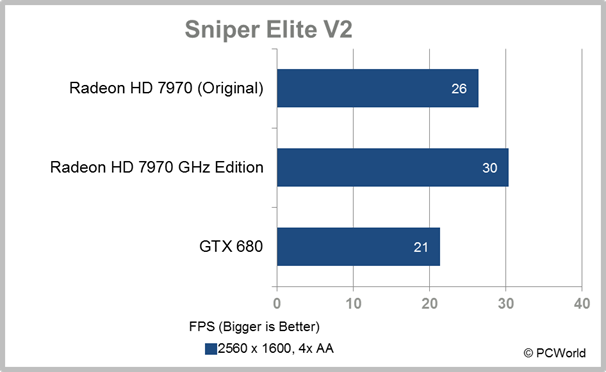
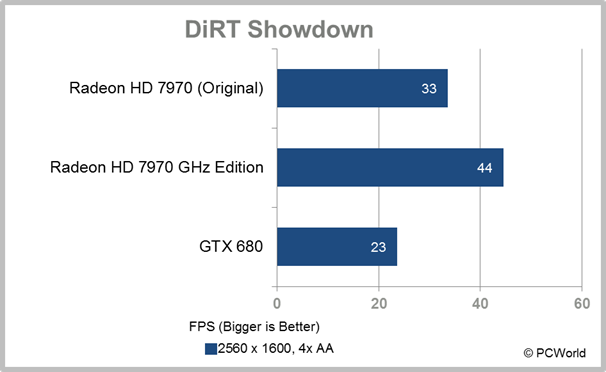
Here, the differences are more dramatic. AMD’s focus on building a
GPU that performs well in both graphics and GPU compute seems to have
paid off. Note that we didn’t test GPU compute heavily, but it’s worth
noting that the latest version of Winzip, Winzip 16.5, offers an option
to enable OpenCL GPU acceleration to compress files. It does make a
difference—an 8GB folder took about 10 percent less time. However, this
option doesn’t appear when a GTX 680 is installed, even with the latest
304.48 beta drivers.
Final Thoughts
Competition is great for consumers. AMD will be shipping the Radeon
HD 7970 GHz Edition in the next couple of weeks, at roughly $499—$100
cheaper than the original and in the same price ballpark as the GTX 680.
On a purely performance basis, the new Radeon wins out over the GTX
680, albeit with a hefty power hit. However, the GTX 680 is quieter,
consumes less power, and is more compact. That may affect your choice.
But if you’re looking for the fastest single GPU card available, AMD
seems to have retaken the crown.

No Response to "AMD Radeon HD 7970 GHz Edition !!eXclusive!!"
Leave A Reply